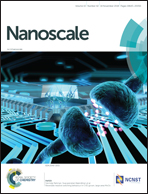Reversible resistive switching behaviour in CVD grown, large area MoOx†
Abstract
Non-volatile resistive memory devices are theorized to be the most promising pathway towards analog memory and neuromorphic computing. Two-dimensional MoO3 is a versatile planar transition metal oxide, whose properties can be readily tuned, making it anywhere from a wide bandgap semiconductor to a semi-metal. Successful integration of such a planar metal oxide into resistive memory can enable adaptive and low power memory applications. Here, we investigate the non-volatile and reversible resistive switching behaviour of oxygen deficient MoOx in a cross-point metal/insulator/metal (MIM) architecture. Layered MoOx films are synthesised using chemical vapour deposition (CVD) and reveal excellent resistive switching performance with relatively low electroforming and operating voltages. Switching ratios of ∼103 and stable data retention of >104 s are achieved. As such, this work demonstrates the viability of MoOx as a resistive memory element and paves the way for future two-dimensional resistive memory technologies.



 Please wait while we load your content...
Please wait while we load your content...